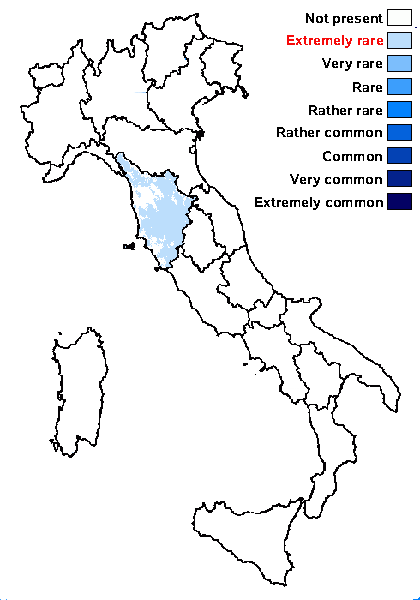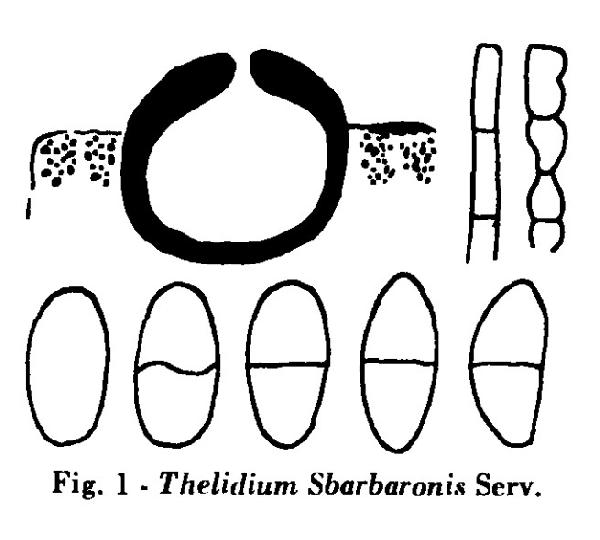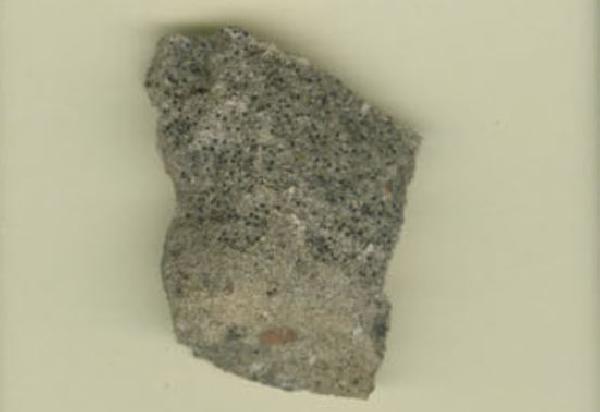Thelidium sbarbaronis Servít
Webbia, 10: 441, 1954.
Synonyms:
Distribution: C - Tosc.
Description: Thallus crustose, hemiendosubstratic, grey, turning green when wet, rimose-areolate, without a distinct prothallus, the areoles 0.2-0.4 mm wide, flat to slightly convex, the surface sometimes granulose. Cortex paraplectenchymatous, up to 20 μm thick, brownish, the cells globose, up to 4 μm wide; algal layer up to 100 μm thick, the algal cells arranged in clusters; medulla white, up to 200 μm thick, partially parenchymatous. Perithecia black, c. 0.35 mm across, immersed in the thallus with at least the lower half, hemispherically projecting with the upper part, which is not covered by thallus, with a poorly evident ostiole. Involucrellum indistinct; exciple globose, brown-black throughout, the wall up to 40 μm thick in lower part, slightly thicker in upper part; hamathecium of up to 40 μm long periphyses, interascal filaments absent; hymenial gel I+ red (I+ blue at very low concentrations of I), K/I + blue. Asci 8-spored, clavate, I-, fissitunicate, the wall thickened above, with an ocular chamber, dehiscent by extrusion of a delicate rostrum, 55-65 x 20-22 μm. Ascospores (0-)1-septate, hyaline, ellipsoid to oblong, 19-26 x 11-14 μm, rounded at both ends. Photobiont chlorococcoid. Spot tests: K-, C-, KC-, P-, UV-. Chemistry: without lichen substances.Note: a very poorly known calcicolous species described from the surroundings of Siena (Solaia) in the submediterranean belt. It is very similar to Th. minutulum, differing in the exciple which is dark throughout.
Growth form: Crustose
Substrata: rocks
Photobiont: green algae other than Trentepohlia
Reproductive strategy: mainly sexual
Poorly known taxon in need of further study
Commonnes-rarity: (info)
Alpine belt: absent
Subalpine belt: absent
Oromediterranean belt: absent
Montane belt: absent
Submediterranean belt: extremely rare
Padanian area: absent
Humid submediterranean belt: extremely rare
Humid mediterranean belt: absent
Dry mediterranean belt: absent

Predictive model
Herbarium samples
Growth form: Crustose
Substrata: rocks
Photobiont: green algae other than Trentepohlia
Reproductive strategy: mainly sexual
Poorly known taxon in need of further study
Commonnes-rarity: (info)
Alpine belt: absent
Subalpine belt: absent
Oromediterranean belt: absent
Montane belt: absent
Submediterranean belt: extremely rare
Padanian area: absent
Humid submediterranean belt: extremely rare
Humid mediterranean belt: absent
Dry mediterranean belt: absent

Predictive model
| Herbarium samples |



